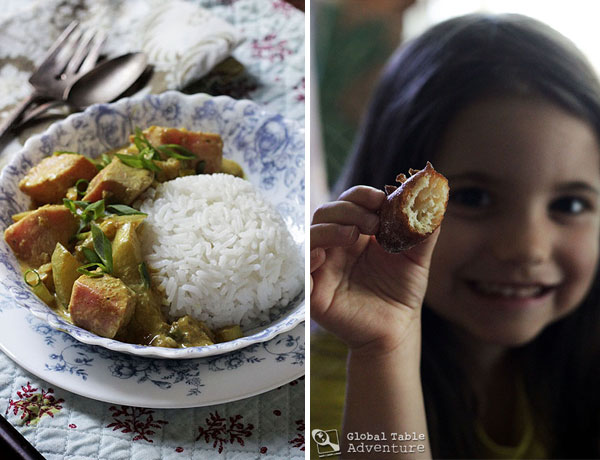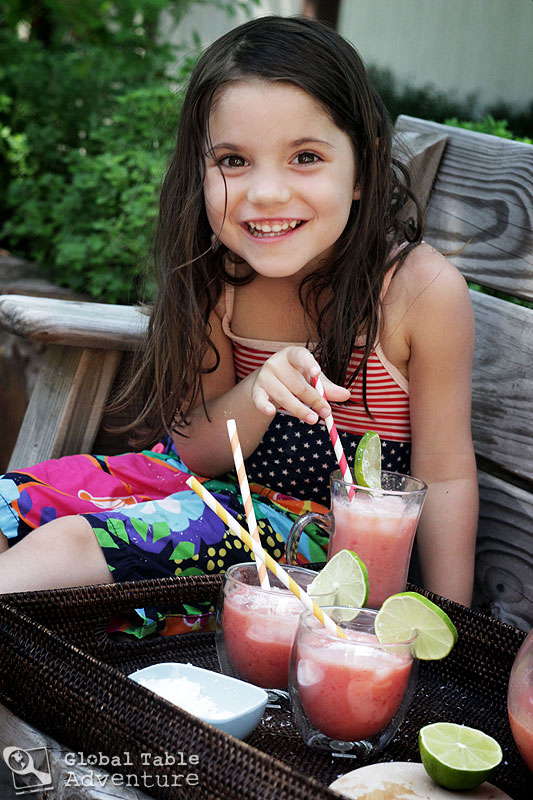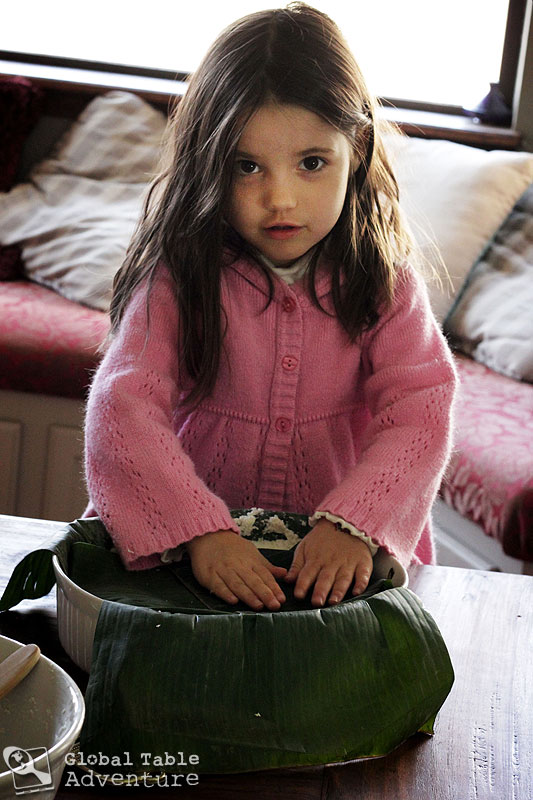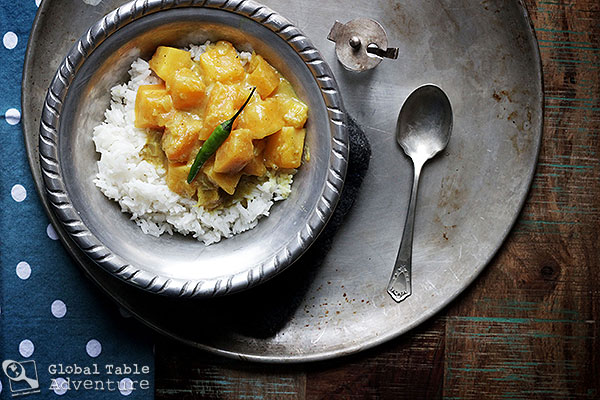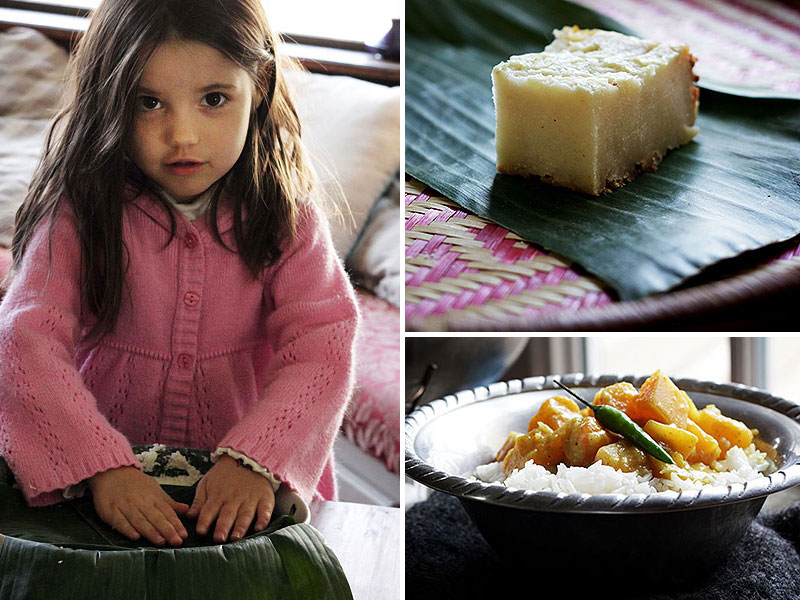Ever wonder how an island nation forms? There’s an old Tuvaluan legend that claims the first inhabitants of Tuvalu were ladies named Pai and Vau. Pai and Vau held baskets of sand. The grains that fell out of those baskets are said to have formed the neighboring atolls (the tiny coral reef islands we learned about yesterday). I love this image. It really goes to show how a little carelessness – something as small as a slip of a basket – can have far-reaching effects. Of course, all this island-making leaves me wondering: what did Pai and Vau ate after making the islands? I’d like to imagine, something like this week’s menu… We’re celebrating the food of Tuvalu with a big bite of local Tuna and doughnut-like banana fritters. This is comfort food, meant to be enjoyed with the salt of the sea on your lips, and a smile in your heart. Even more, we have it on authority that the dessert is fit for the prince of England and his bride. So, it stands …
Read More
This week we’re scooting out into the Pacific, all the way to Tuvalu – a country which is as much fun to eat as it is to say. I wasn’t convinced I’d find much info on these water-lapped islands, especially considering Tuvalu is the fourth smallest country in the world – behind Monaco, Nauru (also in the Pacific), and the Vatican City. It is made up of just three reef islands and six atolls. An atoll is a ring-shaped coral reef like these: There’s generally a lagoon inside. Not a lot of room for growing food. But it does make for some awesome roads. Then I stumbled across Andy Explores and I knew everything would be okay. In this fun spirited blog (by a Boy Scout, no less), Andy takes his readers through his year in Tuvalu. Stories include learning to fish, cooking like a local, waiting for the monthly food shipments (literally just once a month), meeting the epic Graham Hughes (one of two people who have been to every country in the world, including the amazing …
Read More
My family almost didn’t get to try the Sweet Potatoes this week. Twice I screwed up the caramel. Once, Ava was too tired to eat. When she was better rested, I was out of sweet potatoes. It was a comedy of errors. Except I wasn’t laughing, To blow off some steam, Ava and I decided to wash the car. We got on our bathing suits and began to scrub. Dust and bird gunk (and so much more) gradually peeled off the car. As the car cleaned up, something curious began to happen. I began to feel better. Cleansed, even. Ava laughed – no squealed – as she got caught in the spray. And I found myself joining in her joyous refrain. When we were done, we had the watermelon ‘Otai. It was just hot enough, and we were more than thirsty. Ava wasn’t crazy about the chunks of watermelon (although I loved chewing them)… but that wasn’t the point. It never really is. The point is to try it. And to have a little fun in the process. …
Read More
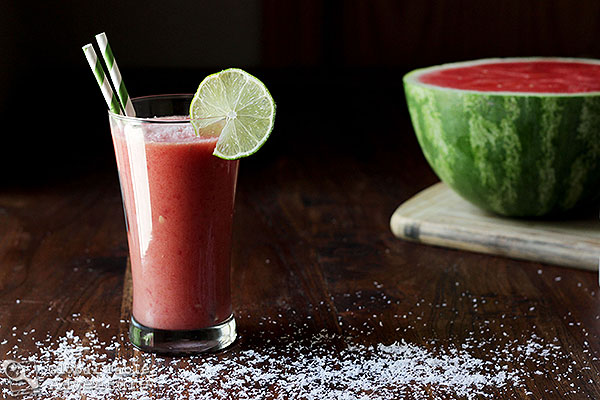
Sun. Sweat. Waves. If lemonade is the go-to poolside drink in the United States, ‘Otai is the go-to ocean-side drink of Tonga. Our recipe for ‘Otai takes us way out into the southwest Pacific, where the tropical days lull a person into putting away their smartphone. Can you imagine? Oh, please, someone take my cellphone from me!! My heart is there already. I promise you won’t need your phone to enjoy this drink. What you do need? A watermelon, a can of coconut milk, and some shredded coconut. If you want to get fancy, you can add things like crushed pineapple or papaya, too. A squeeze of lime juice brightens up the flavors (and looks fancy schmancy) TIP: The watermelon and coconut milk should be very cold. Refrigerate them overnight.. or you could make the drink ahead, and refrigerate it for several hours, or overnight. While you wait, paint your toenails watermelon pink (or is it red?). Use three coats. No biggie. Makes about 1 1/2 quarts Ingredients: 1/2 seedless watermelon (about 5 cups mashed) …
Read More

I love necklaces. The bright stones add a splash of color and fun to my generally plain-Jane outfits. Seeing as I don’t general have time to put on makeup, necklaces are the one and only way to brighten up my look. To make it look like I tried. Well, today, we’re getting a taste of how the islanders in Tonga dress up dinner. In short? Sweet potatoes meet coconut caramel sauce – a vivid display of orange, white, and golden brown. Sweet potatoes and coconut grow easily in the Pacific, making this dish ubiquitous in Tonga. In fact, from what I read, this coconut caramel sauce is on everything in Tonga, from dumplings to taro. Instant goodness. The caramel is just sugar and coconut milk (yay, for an accidentally vegan caramel sauce!). The coconut milk gives the caramel a depth of flavor butter can’t touch. It’s just so tropical. So dressed up. TIP: You can substitute boiled taro, or even boiled dumplings, for the sweet potato in this recipe. Ingredients: 2 lbs sweet potatoes (about 2-3) …
Read More
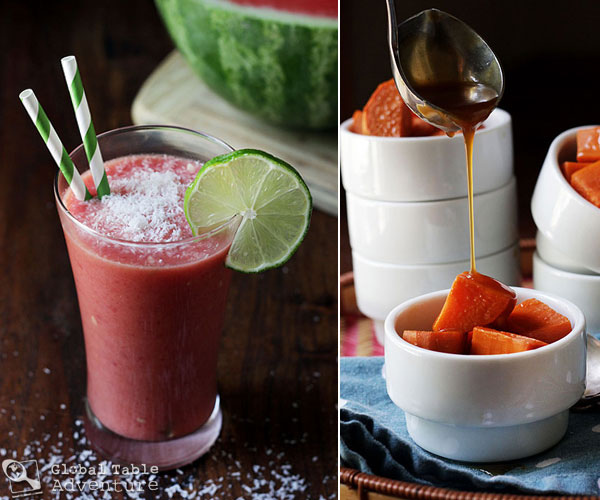
Apparently the fine people of Tonga have quite the sweet tooth. Whether it’s the coconut caramel sauce (which they put on everything from boiled taro to dumplings), or the watermelon chiller, Tonga serves up sweetness in all they do. I for one can appreciate the natural sweetness, especially in the drink. Try the sweet potatoes as a snack or on the side of grilled meats. The drink is great any time of day, but is a perfect alternative to punch or lemonade at your next gathering. Oh, and, yay for an accidentally vegan menu. Because… why not? All recipes and the meal review will be posted throughout the week. Sweet Potatoes in Coconut Caramel Sauce [Recipe] Gussy up your candied sweet potatoes like they do in Tonga -with a totally vegan coconut caramel sauce and a dusting of shredded coconut. Pretty and easy! Coconut Watermelon Refresher | ‘Otai [Recipe] Mashed watermelon blended with coconut milk and shredded coconut. Don’t forget the twist of lime! P.S. As you enjoy your meal, consider sharing the Tongan greeting, which is …
Read More

If you’d like to make some friends, you might want to head over to the “Friendly Islands,” a.k.a. Tonga. There are 170 of these islands to choose from, all dotted through the Southwest Pacific, in Oceania. They got their nickname because they were so kind to Captain Cook when he came there to visit in 1773. Even with all these islands, the CIA World Factbook claims its total area is just four times that of Washington D.C. In this scattered tropical country, vanilla, banana, coconut, and pumpkins grow with ease, despite the tough soil. The soil is best used, perhaps, for underground ovens, where entire pigs can be roasted, along with root vegetables. Once you arrive, stay a while. You can dine on all manner of seafood, along with boiled Taro, Sweet Potatoes [Recipe] or even dumplings… Many Tongans pour on a coconut caramel sauce, to make things even richer. The one with Taro is called Faikakai Topai. As with most of Oceania, Spam is a “thing” – you can find it baked in banana leaves …
Read More
Ava’s been saying something disturbing lately. If a toy breaks, she says “let’s buy a new one.” If fruit sits too long in the basket and gets mushy, she says “let’s go to the grocery store.” She says these things, even with a father who shows her how to build and repair her toys in the garage … Even with a mother who teaches her how to make apple pies with bruised apples. Maybe she says it less than some children, but I’m still concerned, and I’m at a loss with how to handle it. Our week cooking the Solomon Islands brought the issue into clear relief. In the Solomon Islands, food is incredibly difficult to grow. There’s mountains. Monsoons. On the remote islands, locals might have to row to another island just to get to the grocery store. You get the drift. Food is not to be wasted. Families must make due with what they have. This includes eating green papaya and grated cassava, wrapped up in banana leaves, some of the rare indigenous foods. So, …
Read More
It’s just as important to be frugal in times of plenty as it is in times of hardship. As my mom likes to say “Waste not, want not.” In the Solomon Islands, when Papaya trees hang heavy with more fruit than locals know what to do with, they don’t let it rot and fall to the ground. They don’t let the monsoons sweep the fruit away, either. Oh, no. Instead, they make use of the papaya at every stage of growth… ripe or unripe… which is how PawPaw Curry makes its way onto the dinner table. While the sweet flesh of ripe papaya is grand (perhaps baked with sweet coconut cream?), pawpaw curry is made with the mild, firm flesh of an unripe papaya. A green papaya. Unlike the deep orange interiors of their ripe sisters, green papayas are pastel on the inside, just barely dawning with orange. The flesh is mild in flavor and takes on the personality of whatever ingredients they are cooked with. In this case, curry and coconut milk makes for …
Read More
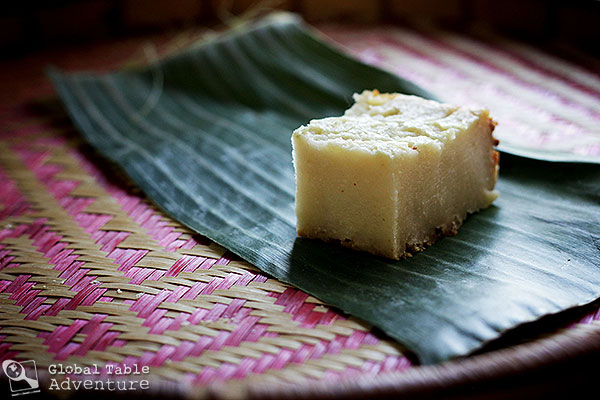
I secretly love it when a word like “pudding” takes on a whole new meaning than “the sweet chocolate goop found in the refrigerator cases of American supermarkets” (although I do enjoy that sort of pudding as much as the next sugar crazed mom). I love surprises like this because they teach me not to take so much for granted. They remind me that there are people all over this beautiful world who have different ways of doing things. And, in case you didn’t get the memo, different is a beautiful thing. Imagine how boring our world would be if we all looked the same, talked the same, and… ate the very same pudding? In Solomon Islands and throughout Oceania, pudding is any goupy mixture that’s been grated and baked. Or sometimes steamed. Confused? Let’s get specific. The most popular pudding in Solomon Islands is Cassava Pudding. This is more of a savory cake than pudding. It’s made with grated cassava, sweet potato, and coconut milk. The whole shebang is traditionally baked all afternoon in …
Read More
When wind, ice rain, and snow blast our home, I shut my eyes and escape to Solomon Islands for a little imagination vacation. It doesn’t become real, though, until I try the food. What I find, more than anything else, is that the traditional food relies heavily on that which can grow on the islands. This is limited to staples like coconut, papaya, taro, sweet potatoes, and cassava. There would have been a time when 80% of these ingredients would have scared me off. Not because there’s anything wrong with them,* but because I would have no idea what to do with them. Heck. I wouldn’t have even known what they were. But, this is our 160th country. After this week, there’s only 36 weeks left. I’m not scared any more. I’m excited. Curious. Open. So here’s what we made. All recipes and meal review will be posted throughout the week. PawPaw Curry [Recipe] Take green papaya (a.k.a. not ripe) and cook it down with sweet onion, coconut milk, and a blast of homemade curry powder. …
Read More
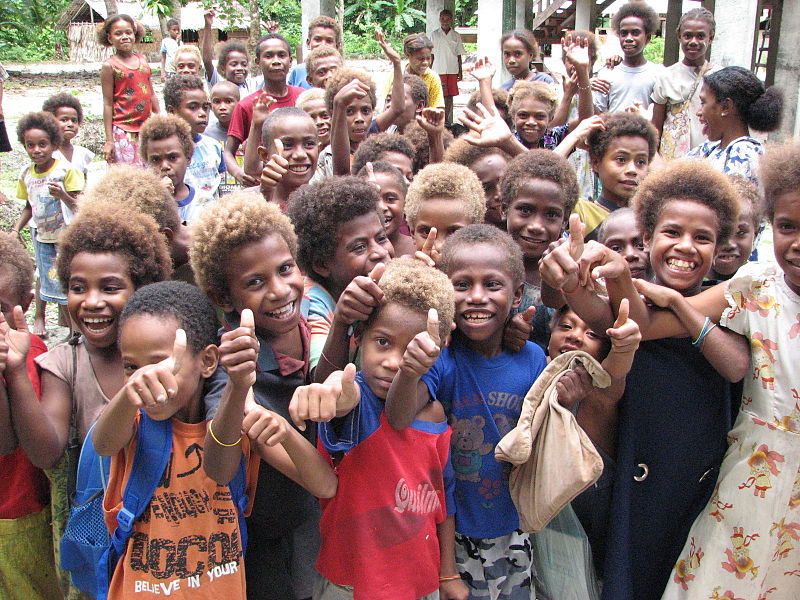
This week’s country meets the ocean with two faces. On one side are her cliffs, razor sharp and formidable On the other are gentle slopes. The two are connected by a central spine of mountains. This is the Solomon Islands, a collection of islands to the northeast of Australia, just east of Papua New Guinea. In this tropical land, many houses are built on stilts and about 80% of islanders live in the boondocks. The Pacific Ocean is as much a valued friend, relied on for nourishment in the form of fish, lobster, and crustaceans, as it is an inestimable danger in times of storm or tsunami. Finding information about food on the islands required quite a bit of detective work, which ultimately led me to a fascinating collection of blogs created by volunteers visiting the islands. Of these, Stilettos in the Solomons gave the most helpful overviews (and had the most intriguing name). Like much of the Pacific, crops are limited to what can grow along rugged mountains, not to mention they must be hardy enough to …
Read More

